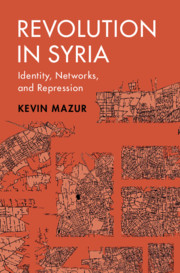Book contents
- Revolution in Syria
- Cambridge Studies in Comparative Politics
- Revolution in Syria
- Copyright page
- Dedication
- Contents
- Figures
- Tables
- Acknowledgments
- A Note on Transliteration
- 1 Introduction
- 2 Theory
- 3 Networks, Identities, and Patronage in Contemporary Syria
- 4 Events of the Syrian Uprising
- 5 Initial Forms of Challenge
- 6 State Networks and Nonparticipation
- 7 Logics of State Repression and Societal Response
- 8 Particularizing Challenge in Kurdish Areas
- 9 Conclusion
- Appendix
- Chronology of Major Events in the First Year of the 2011 Syrian Uprising
- References
- Index
- Series page
5 - Initial Forms of Challenge
Published online by Cambridge University Press: 18 June 2021
- Revolution in Syria
- Cambridge Studies in Comparative Politics
- Revolution in Syria
- Copyright page
- Dedication
- Contents
- Figures
- Tables
- Acknowledgments
- A Note on Transliteration
- 1 Introduction
- 2 Theory
- 3 Networks, Identities, and Patronage in Contemporary Syria
- 4 Events of the Syrian Uprising
- 5 Initial Forms of Challenge
- 6 State Networks and Nonparticipation
- 7 Logics of State Repression and Societal Response
- 8 Particularizing Challenge in Kurdish Areas
- 9 Conclusion
- Appendix
- Chronology of Major Events in the First Year of the 2011 Syrian Uprising
- References
- Index
- Series page
Summary
This chapter examines the causes of initial mobilization against the Syrian regime. Contention in the first weeks of the Syrian uprising followed multiple logics. Urban activists organized demonstrations in central public squares, making demands focused overwhelmingly on how power is exercised in the center and on establishing a new citizenship contract. At the same time, challenge broke out in smaller localities, independent of that occurring in other sites, and focused primarily on the grievances of local populations. The emergence of citizenship-focused challenge was the result of activists’ utilization of public spaces, with initial demonstrations encouraging the formation of new networks in the early weeks of contention. Parochial challenge, by contrast, developed on the basis of preexisting dense networks within local communities. Demands were articulated largely in a local idiom and went primarily through preexisting channels of state–society communication; when state agents violated shared understandings of the terms of these interactions by using violence against community members, challengers often responded with violence of their own.
Keywords
- Type
- Chapter
- Information
- Revolution in SyriaIdentity, Networks, and Repression, pp. 122 - 159Publisher: Cambridge University PressPrint publication year: 2021



